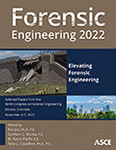BIM and Building Emergency Response Management: Review of Applications
Publication: Forensic Engineering 2022
ABSTRACT
With recent increases in deadly fires, earthquakes, and terror attacks, the need for implementing new technologies to achieve maximum disaster preparedness in public and densely populated buildings is paramount. Building Information Modeling (BIM) enables the development of data-rich models that can be used for simulation and emergency response management. In this study, to evaluate the applications of BIM-based analysis in emergency response practices, a comprehensive literature review is performed. This paper investigates the applications of BIM in different phases of in-building disasters and highlights major applications of BIM as (1) preventing failure by facilitating predictive maintenance, (2) evacuation planning and guidance, (3) improving decision-making for rescue team by real-time two-way information updating, and (4) finding the root causes of failure. Finally, the gaps and challenges for each aspect are addressed and discussed.
Get full access to this article
View all available purchase options and get full access to this chapter.
REFERENCES
Alvanchi, A., and Seyrfar, A. (2020). “Improving facility management of public hospitals in Iran using building information modeling.” Scientia Iranica, 27(6), 2817–2829.
Blas, M. J., and Gonnet, S. (2021). “Computer-aided design for building multipurpose routing processes in discrete event simulation models.” Engineering Science and Technology, an International Journal, 24(1), 22–34.
Cao, S., Song, W., and Lv, W. (2016). “Modeling pedestrian evacuation with guiders based on a multi-grid model.” Physics Letters A, 380(4), 540–547.
Chen, A. Y., and Chu, J. C. (2016). “TDVRP and BIM integrated approach for in-building emergency rescue routing.” Journal of Computing in Civil Engineering, 30(5), C4015003.
Chen, A. Y., and Huang, T. (2015). “Toward BIM-enabled decision making for in-building response missions.” IEEE Transactions on Intelligent Transportation Systems, 16(5), 2765–2773.
Chen, X.-S., Liu, C.-C., and Wu, I.-C. (2018). “A BIM-based visualization and warning system for fire rescue.” Advanced Engineering Informatics, 37, 42–53.
Cheng, J. C. P., Chen, W., Chen, K., and Wang, Q. (2020). “Data-driven predictive maintenance planning framework for MEP components based on BIM and IoT using machine learning algorithms.” Automation in Construction, 112, 103087.
Cheng, M.-Y., Chiu, K.-C., Hsieh, Y.-M., Yang, I.-T., Chou, J.-S., and Wu, Y.-W. (2017). “BIM integrated smart monitoring technique for building fire prevention and disaster relief.” Automation in Construction, 84, 14–30.
Choi, J., Choi, J., and Kim, I. (2014). “Development of BIM-based evacuation regulation checking system for high-rise and complex buildings.” Automation in Construction, 46, 38–49.
Eastman, C. M., Eastman, C., Teicholz, P., Sacks, R., and Liston, K. (2011). BIM handbook: A guide to building information modeling for owners, managers, designers, engineers and contractors. John Wiley & Sons.
Eftekharirad, R., Nik-Bakht, M., and Hammad, A. (2018). “Extending IFC for fire emergency real-time management using sensors and occupant information.” Proceedings of the 34th International Symposium on Automation and Robotics in Construction, 35, 1–8.
Lu, Q., Chen, L., Lee, S., and Zhao, X. (2018). “Activity theory-based analysis of BIM implementation in building O&M and first response.” Automation in Construction, 85, 317–332.
Ma, G., and Wu, Z. (2020). “BIM-based building fire emergency management: Combining building users’ behavior decisions.” Automation in Construction, 109, 102975.
Matthews, S., Sullivan, A., Gould, J., Hurley, R., Ellis, P., and Larmour, J. (2012). “Field evaluation of two image-based wildland fire detection systems.” Fire Safety Journal, 47, 54–61.
Motamedi, A., Hammad, A., and Asen, Y. (2014). “Knowledge-assisted BIM-based visual analytics for failure root cause detection in facilities management.” Automation in Construction, 43, 73–83.
Ran, H., Sun, L., and Gao, X. (2014). “Influences of intelligent evacuation guidance system on crowd evacuation in building fire.” Automation in Construction, 41, 78–82.
Rozo, K. R., Arellana, J., Santander-Mercado, A., and Jubiz-Diaz, M. (2019). “Modelling building emergency evacuation plans considering the dynamic behaviour of pedestrians using agent-based simulation.” Safety Science, 113, 276–284.
Rüppel, U., and Schatz, K. (2011). “Designing a BIM-based serious game for fire safety evacuation simulations.” Advanced Engineering Informatics, 25(4), 600–611.
Shalabi, F., and Turkan, Y. (2017). “IFC BIM-based facility management approach to optimize data collection for corrective maintenance.” Journal of Performance of Constructed Facilities, 31(1), 4016081.
Sun, Q., and Turkan, Y. (2020). “A BIM-based simulation framework for fire safety management and investigation of the critical factors affecting human evacuation performance.” Advanced Engineering Informatics, 44, 101093.
U.S. fire statistics: Trends in Fires, Deaths, Injuries and Dollar Loss. (2020). U.S. Fire Administration. https://www.usfa.fema.gov/data/statistics/ (Feb. 2, 2021).
Wang, B., Li, H., Rezgui, Y., Bradley, A., and Ong, H. N. (2014). “BIM based virtual environment for fire emergency evacuation.” The Scientific World Journal, 2014.
Wang, S.-H., Wang, W.-C., Wang, K.-C., and Shih, S.-Y. (2015). “Applying building information modeling to support fire safety management.” Automation in Construction, 59, 158–167.
Yuan, F. (2011). “Video-based smoke detection with histogram sequence of LBP and LBPV pyramids.” Fire Safety Journal, 46(3), 132–139.
Information & Authors
Information
Published In
History
Published online: Nov 2, 2022
Authors
Metrics & Citations
Metrics
Citations
Download citation
If you have the appropriate software installed, you can download article citation data to the citation manager of your choice. Simply select your manager software from the list below and click Download.
